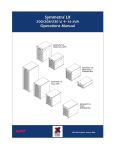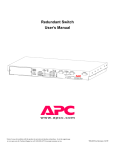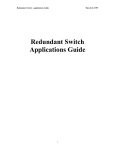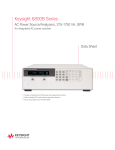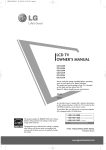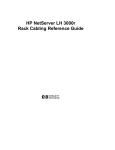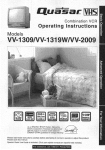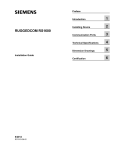Download APC Automatic TransferSwitch Owner`s manual
Transcript
APC Redundant Switch Installation and Operation Manual ® www.APCturkey.com Pre-Installation Procedures Receiving inspection Inspect the package and contents for shipping damage, and make sure that all parts were sent. Report any damage immediately to the shipping agent, and report missing contents, damage, or other problems immediately to APC or your APC reseller. Please recycle The shipping materials are recyclable. Please save them for later use, or dispose of them appropriately. Package contents The package contains the following • The Redundant Switch • The Redundant Switch hardware kit (OM-8500): Part Number Description Quantity 870-7190 Left Mounting Bracket 1 870-7191 Right Mounting Bracket 1 820-0022 Twist Locks 2 808-0004 Pan-head Phillips Screws with washers 4 • The 1U mounting rails • The 1U mounting rails hardware Kit (OM-7600) Select the installation site Part Number Description Quantity 810-0002 Ornamental Screw 10-32 4 810-2004 Snap-on Speed Nut 10-32 4 810-2008 Cage Nut 10-32 4 Choose a temperature-controlled area (0° – 50° C, 32° – 122° F), free of conductive contaminants. Available Models Following is a rear view and basic information for each available Redundant Switch model. Model SU041 CA UTION: ® LISTE D 42C 2 E95463 LR 6393 8 UNINT ERRU PTIBLE RISK OFELECTRIC SHOCK. DO NOT REMOVE TOP COVER. NO USER POW ER SUPPLY SERVICEABLE PARTSI NSI DE. REFERSERVICINGTO QUALIFIEDSERVICE PERSONNEL. ACCESSO RY FOR USE IN A CONTROLLED ENVIRONMENT. REFER TO MANUAL FOR ENVIRONMENTAL CONDIT IONS. MADE IN USA THIS EQUIPMENT USEST WO(2)ACSOURCES MOD EL : S/N: THIS DEVICE COMPLIESWITHPART 15OF THEFCCRULES. OPERATION ISSUBJECT TO THEFOLLOWING TWOCONDITIONS : 1.THISDEVICE MAY NOT CAUSE HARMFUL INTERFERENCE AND 2.THISDEVICE MUST ACCEPT ANY INTERFERENCE RECEI VED THATMAY CAUSE UNDESIRED OPERATION. Voltage Source (Input) Load (Output) 1400 VA 120 V 2 NEMA 5-15 2 NEMA 15-5 Voltage Source (Input) Load (Output) 3000 VA 120 V 2 NEMA L5-30 2 NEMA 5-20 Model SU042-1 CA UTION: ® LISTE D 42C 2 LR 6393 8 E95463 UNINT ERRU PTIBLE RISK OF ELECTRIC SHOCK. D O NOT REMOVE TOP COVER. NO USER POW ER SUPPLY SERVICEABLE PARTSINSI DE. REFERSERVICINGTO QUALIFIEDSERVICE PERSONNEL. ACCESSO RY FORUSE IN ACONTROLLEDENVIRONMENT. REFERTOMANUAL FOR ENVIRONMENTALCONDITIONS . MADE IN USA THIS EQUIPMENT USESTWO(2)ACSOURCES MOD EL : S/N: THIS DEVICE COMPLIESWITHPART 15OF THE FCCRULES. OPERATION ISSUBJECT TO THEFOLLOW ING TWOCONDITIONS : 1.THISDEVICE MAY NOT CAUSE HARMFUL INTERFERENCE AND 2.THISDEVICE MUST ACCEPT ANY INTERFERENCE RECEI VED THAT MAY CAUSE UNDESIRED OPERATION. For information on the circuit breaker safety device and load indicator for this model, see “Features of models SU042-1 and SU042-4” on page 5. Model SU042-2 CAU TION: ® LISTE D 42C 2 LR 63938 E95463 UNINT ERRUPT IBLE RISK OF ELECTRICSHOC K POW ER SU PPLY SERVICEABLE PARTSINSIDE. REFERSERVICINGTO QUALIFIED SERVICE PERSONNEL. ACCESSORY FORUSE INACONTROLLEDENVIRONMENT. REFERTOMANUAL FOR ENV IRONMENTALCONDITIONS . MADE IN USA THIS EQUIPMENT USESTWO(2) ACSOURCES THIS DEVICE COMPLIESWITH PART 15OF THEFCCRULES. OPERATION ISSUBJECT TOTHEFOLLO WING TWOCONDITION . DO NOT REMOVE TOP COVER. NO USER MOD EL : S/N : S: 1.THISDEVI CE MAY NOT CAUSE HARMFUL INTERFERENCE AND 2.THISDEVI CE MUST ACCEPT ANY INTERFERENCE RECEIVED THAT MAY CAUSEUNDESIREDOPERATION. Voltage Source (Input) 3000 VA 120 V 2 NEMA L5-30 Load (Output) 1 NEMA L5-30 (captive cord) Available Models Model SU042-4 Voltage Source (Input) 3000 VA 120 V 2 NEMA L5-30 Load (Output) 6 NEMA 5-20 (limited to 15 A from the circuit breaker) For information on the circuit breaker safety device and load indicator for this model, see “Features of models SU042-1 and SU042-4” on page 5. Model SU043 IN PU T V O LTA G E: 2 2 0- 24 0 VA C MO D EL 1 40 0 3 00 0 Ge pr ü ft e S ic he rh ei t MO DEL : S/N: MA X I 8A 1 6A Voltage Source (Input) Load (Output) 1400 VA 230 V 2 IEC 320 C14 2 IEC 320 C13 Model SU044-1 SEE OWNER'S MANUAL IN PU T V O LTA G E: 2 x AC 2 2 0- 24 0V ; 5 0-6 0 Hz Ge pr ü ft e S ic he rh ei t M O D EL I NP U T S U 043 2 x 8 A (1 4 0 0 VA ) O U T PU T MO DEL : S/N: 2 x AC 2 2 0 -2 4 0 V; 2 x 8 A S U 0 4 4 - 1 2 x 1 6 A ( 3 0 0 0 V A ) 2 x A C 2 2 0 - 2 4 0 V ; 1 x 1 6 A ,2 x 8 A S U 0 4 4 -2 2 x 1 6 A (3 0 0 0 VA ) 2 x AC 2 2 0 -2 4 0 V; 2 x 1 6 A Voltage Source (Input) Load (Output) 3000 VA 230 V 2 IEC 320 C20 1 IEC 320 C19 2 IEC 320 C13 Available Models Model SU045-1 CAU TION: ® LISTE D 42C 2 LR 63938 E95463 UNINT ERRUPT IBLE RIS KOF ELECTRIC SHOCK. POW ER SU PPLY SERVICEABLE PARTSINSIDE. REFER SERVICINGTOQUALIFIEDSERVICE PERSONNEL . ACCESSOR Y FORUSE IN ACONTROLLEDENVIRONMENT. REFERTO MANUAL FOR ENVIRONMENTAL MADE IN USA THIS EQUIPMENT USESTWO(2) AC SOURCES THIS DEVICE COMPLI ES WI THPART 15OFTHE FCCRULES. OPERATION ISSUBJECT TOTHEFOLLOWINGTWOCONDITION DO NOT REMOVE TOP COVER. NO USER CONDIT IONS . MOD EL : S/N : S: 1.THISDEVICE MAY NOT CAUSE HARMFUL INTERFERENCEAND 2.THISDEVICE MUST ACCEPT ANY INTERFERENCE RECEI VED THAT MAY CAUSE UNDESIREDOPERATION. Features of models SU042-1 and SU042-4 Voltage Source (Input) 3000 VA 208 V 2 NEMA L6-20 Load (Output) 1 NEMA L6-20 (captive cord) Safety device. Models SU042-1 and SU042-4 have a red circuit breaker safety device attached to each circuit breaker switch. Do not remove this device. • The device prevents accidentally tripping of the circuit breaker, but allows the automatic tripping of the breaker that protects your equipment when an overload or malfunction occurs. • To turn the circuit breaker off when necessary, pull the left end of the safety device forward so that it no longer blocks the switch, then push the switch to the OFF position. • To reset a circuit breaker that has tripped automatically: – Pull the left end of the safety device forward so that it no longer blocks the switch. – Let the switch move fully to the left, then push it to the right. – Push the left end of the safety device back into place to block the switch. Outlet Control indicator. The number to the left of each circuit breaker switch indicates which set of outlets it controls: LOAD 1 or LOAD 2. Installation Install management products and the UPS 1. Before you plug in the Redundant Switch and the two UPSs, install any compatible APC management products: – If you use a Web/SNMP Management Card, install it in the card slot of the preferred APC Smart-UPS, not in the card slot of the Redundant Switch. – Always use the card slot in the Redundant Switch for any other compatible APC management product, such as the Environmental Monitoring Card. The Redundant Switch inlets are the main disconnect devices. Note For multiple APC accessory configurations, visit the APC Web site 2. To install each UPS, follow the installation instructions in the UPS User’s Manual. – Make sure both UPSs are the same sine-wave model. – Plug the power cords attached to the Redundant Switch into each UPS. Installation Attach the brackets to the Redundant Switch Attach the two included brackets to the Redundant Switch. The following example shows how to attach the bracket for the right side. (Attach the left bracket in the same manner.) 1. To allow space to route the cables and to place the connectors flush with the front of the rack, align the second hole from the front of the bracket with the first hole in the side of the Redundant Switch. 2. Insert and tighten the screws that are provided. Installation Install the rails (4-post rack only) Mount the rails only if you are using a four-post rack. (In a two-post rack, you mount the Redundant Switch by the brackets alone.) For information on which clips and screws your rack requires, see Appendix A: Rack-Mount Supplement. " # For a four-post rack: 1. Prepare the rack’s rail-holes for mounting the brackets and rails of the Redundant Switch. 2. Disassemble each rail by removing the slide screw and nut !. Set aside the screw, nut, and front segment " of the rail. 3. Mount the end # of the rear segment of each rail to the rear rails on the prepared rack, using appropriate rack hardware. Installation 4. On each side, attach the front rail segment that you set aside in step 2 to the Redundant Switch. a. Align the top two holes on the front rail segment with the two holes on the side (toward the rear) of the Redundant Switch. b. Attach the rail segment with the tapered-head screws provided. Installation Connect and route the cables 1. To the front of the Redundant Switch, connect the communications cable and any accessory cables that require front connections. 2. Route the cables around the Redundant Switch through the side channel (marked with arrows below) to the equipment in the rack. Redundant Switch 3. Optionally, install a plastic twist-lock (provided) on each side to secure the cables. Installation Mount the Redundant Switch in the rack Use two people to lift the Redundant Switch. Heavy 1. Slide the front rail segments attached to the Redundant Switch into the rear rail segments attached to the rack. 2. From the rear of the rack, insert and tighten the slide screws and nuts. Connect your equipment Do not connect laser printers through the Redundant Switch Caution 1. Use your server’s power cords to connect to the Redundant Switch. 2. Connect a communications cable (940-1000A) between each UPS and the Redundant Switch. Make sure that the communications cable and the power cord for the preferred UPS (UPS-A) are connected to the same UPS. Note If there are not enough outlets to connect all your equipment, use a Rack-mount PDU, available . through the APC Web site, Installation Turn on the equipment and Redundant Switch Connect the PowerChute® cable 1. Turn on all connected equipment. 2. To provide power to the equipment, press the ON button of UPS-A to turn on the Redundant Switch and UPS-B. 3. To test whether the cables are connected correctly, press the OFF button on one UPS. – If it turns back on, the cabling is correct. – If it does not turn back on, try swapping the two UPS communications cables to correct the problem. When you are ready to install PowerChute plus, install the PowerChute plus communications cable between the server port of the Redundant Switch and your server’s serial port. Note To use PowerChute plus software to manage a Redundant Switch configuration, your server must be running Windows NT, Solaris, or NetWare. See your PowerChute plus documentation for the operating system versions that are supported. Configuration Supported configurations Two supported configurations for Redundant Switch are shown below. For more information on these and other supported configurations, visit the APC Web site . Install only SNMP accessories in the UPS. You must install any other accessories in the Redundant Switch Note Both UPSs must be the same sine-wave model. Minimum acceptable configuration: Redundant Switch with two Smart-UPS units connected to one AC line (the same facility power source). Best configuration: Redundant Switch with two Smart-UPS units connected to two separate AC lines (each UPS receiving power from a separate facility power source). Configuring PowerChute 1. Install PowerChute plus as described in the enclosed software installation instructions. plus 2. For Source B: a. At the Redundant Switch front panel, set the Source Preference to Source B. b. Start the computer on which PowerChute plus is installed. c. Start PowerChute plus. Communication is to UPS-B. d. Configure UPS-B according to your requirements. e. Set the UPSID to UPS_B. 3. For Source A: a. At the Redundant Switch front panel, set the Source Preference to Source A. Configuration b. Restart the computer on which PowerChute plus is installed. c. Start PowerChute plus. Communication is to UPS-A. d. Configure UPS-A according to your requirements. e. Set the UPSID to UPS_A. When one UPS becomes unavailable When one of the two UPSs becomes unavailable to supply AC power, PowerChute plus sends the message “Self test failed: invalid test.” Any of the following conditions will cause the message to occur: • A UPS self-test fails. • Communication with the alternate UPS is lost. • The voltage of the alternate UPS is out of range. • UPS-A fails, and the Redundant Switch transfers the power input and PowerChute plus communication to UPS-B. To regain high availability for your system, correct the problem as soon as possible. See “Troubleshooting” on pa ge18. Note When any self-test of the primary UPS occurs, the Redundant Switch switches power and communication to the other UPS, causes a selftest of that UPS, and then switches back. This is normal behavior. Operation Controls, LEDs, and ports on the front panel Redundant Switch Storage APC recommends the factory default settings among the settings shown below. Note Function Source A Sensitivity Source B Sensitivity Source Preference LED Display Description Bright= Normal Dim (the factory default) = Reduced Sets transfer sensitivity to line conditions Off = low Bright = Source A (the factory default) Dim = Source B Selects the preferred AC source Off = none Source A Xfer Voltage Bright = Narrow Source B Xfer Voltage Off = Wide Dim = Medium (the factory default Sets the transfer voltage window (the range of acceptable voltage) Operation Emergency Power Off You can use a remotely operated Emergency Power Off (EPO) switch to turn off the UPS and disconnect power to the equipment load. When you turn off the UPS through the Emergency Power Off system, it will turn off immediately without switching to battery operation. Electrical Hazard Use only a licensed electrician to perform the following procedure to connect the Redundant Switch and its attached UPSs to your Emergency Power Off system. 1. Use the EPO connector. 2. Use a normally-open contact to connect the +24 terminal to the IN terminal. 3. Wire the external blue four-pin female connector to the emergency power off system. The EPO interface is a Safety Extra Low Voltage (SELV) circuit. Connect it only to other SELV circuits. Caution The EPO interface monitors circuits that have no determined voltage potential. Such closure circuits may be provided by a switch or relay properly isolated from the utility. To avoid damage to the Redundant Switch, do not connect the EPO interface to any circuit other than a closure type circuit. Operation Front panel programmable settings The following programmable settings are accessible using controls located on the Redundant Switch front panel. Function Select LED Indicator. The three green Function Select LEDs indicate which user programmable parameter is selected for status display or modification. Use the left selection button to cycle through the five configurable items defined in “Controls, LEDs, and ports on the front panel” on page 15. Function Status LED Indicator. The green Function Status LED indicates the state of the selected user programmable function. Use the Select button to cycle among the choices. AC Source LED Indicator. The green online LED indicates the line quality and selection status of each source: LED Display Status of Source Bright Source is selected. Dim Source is OK, but not selected. Off Source is not OK. One LED is flashing once per second, and the other LED is off Both AC sources are out of tolerance. Source Sensitivity and Transfer Voltage. APC recommends that you do not change these settings, which are correct for most conditions. See “Controls, LEDs, and ports on the front panel” on page 15. Troubleshooting Basic troubleshooting Electrical Hazard Only trained APC technicians should open the Redundant Switch for repair. Problem Possible Cause Corrective Actions Very low utility voltage, or no utility voltage. Use a lamp with an incandescent bulb to test the AC power supply to the Redundant Switch. If the bulb lights very dimly or not at all, have the utility voltage checked. Ensure that the AC cables are properly connected between the Redundant Switch and the UPSs. The server cannot communicate with the attached UPS through the Redundant Switch A cabling problem or internal Redundant Switch fault Ensure that all cables connections are securely connected. If there is still no communication, connect the server directly to a UPS. If you can establish communication by this direct connection, there is an internal Redundant Switch fault. Contact APC Customer Support. All Redundant Switch LEDs are flashing An Internal, automated selftest failure occurred; the Redundant Switch is defective. See “Obtaining service” on page 25. The Redundant Switch will not turn on. For computer interface port specifications, see the APC Web Troubleshooting Troubleshooting communications and lost redundancy With the high availability system, the attached UPSs are polled continuously for capability to carry a load and ability to communicate with the management software (PowerChute plus). When a problem with one of the UPSs occurs, power to the load is not interrupted and polling continues, and PowerChute plus responds by displaying the message, “Self test failed: invalid test.” Communications Problems. If the message “Self test failed: invalid test.” occurs repeatedly: 1. Check the communications path between the UPSs and the Redundant Switch. 2. Check the front panel of the Redundant Switch. – If the Status Select LEDs are flashing in any sequence, the Redundant Switch has failed. See “Basic troubleshooting” on page 18. – If the front panel appears normal, there may be a UPS or server communications problem, See the troubleshooting and service sections of your UPS manuals. – If you need more help, contact APC Worldwide Customer Support. Loss of Redundancy. If the Redundant Switch LED for UPS-B is off, UPS-B has lost the ability to provide power to the equipment load when engaged. If the LED for UPS-A is off, UPS-A has failed, and power is now provided by UPS-B. See the troubleshooting and service sections of your UPS manuals. If PowerChute plus displays the message “self test failed: invalid test” briefly or several times, the output voltage of UPS-A has dropped. Perform a UPS self-test through PowerChute plus. • If the self test fails, see the troubleshooting and service sections of your UPS manuals. • If you need more help, contact APC Worldwide Customer Support. Specifications SU041, SU042-1, SU042-2, and SU042-4 Item Specification Power Nominal input voltage 120VAC Input voltage range 0 – 165 VAC Frequency range 47 – 63 Hz Normal sensitivity transfer times 8 ms maximum at 60 Hz 10 ms maximum at 50 Hz Reduced sensitivity transfer times 16 ms maximum at 60 Hz 20 ms maximum at 50 Hz Maximum current draw 12A (SU041 model) 24A (SU042 models) Physical Size: 1.75 × 17.0 × 7.5 in 4.45 × 43.2 × 19 cm Net weight 10 lb (4.5 kg) Shipping weight 15 lb (6.8 kg) Environmental Elevation (above MSL): • Operating • Storage 0 to 10,000 ft (0 to 3000 m) 0 to 50,000 ft (0 to 1500 m) Temperature: • Operating • Storage 32° to 122° F (0 to 50° C) 5° to 122° F (– 15° to 50° C) Relative Humidity (Operating and Storage) 0 to 95%, non-condensing Approvals/Standards UL, CSA, FCC Class A Specifications SU043 and SU044-1 Item Specification Power Nominal input voltage 230VAC Input voltage range 0 – 325 VAC Frequency range 47 – 63 Hz Normal sensitivity transfer times 4 ms typical, 8 ms maximum at 60 Hz 5 ms typical, 10 ms maximum at 50 Hz Reduced sensitivity transfer times 8 ms typical, 16 ms maximum at 60 Hz 10 ms typical, 20 ms maximum at 50 Hz Maximum current draw 6 A (SU043 model) 13A (SU044-1 model) Physical Size: 1.75 × 17.0 × 7.5 in 4.45 × 43.2 × 19 cm Net weight 10 lb (4.5 kg) Shipping weight 15 lb (6.8 kg) Environmental Elevation (above MSL): • Operating • Storage Temperature: • Operating • Storage Relative Humidity (Operating and Storage) 0 to 10,000 ft (0 to 3000 m) 0 to 50,000 ft (0 to 1500 m) 32° to 122° F (0 to 50° C) 5° to 122° F (– 15° to 50° C) 0 to 95%, non-condensing Approvals/Standards CE, VDE, EN55022, EN55024 Specifications SU045 Item Specification Power Nominal input voltage 208VAC Input voltage range 0 – 275 VAC Frequency range 47 – 63 Hz Normal sensitivity transfer times 4 ms typical, 8 ms maximum at 60 Hz 5 ms typical, 10 ms maximum at 50 Hz Reduced sensitivity transfer times 8 ms typical, 16 ms maximum at 60 Hz 10 ms typical, 20 ms maximum at 50 Hz Maximum current draw 14A Physical Size: 1.75 × 17.0 × 7.5 in 4.45 × 43.2 × 19 cm Net weight 10 lb (4.5 kg) Shipping weight 15 lb (6.8 kg) Environmental Elevation (above MSL): • Operating • Storage Temperature: • Operating • Storage Relative Humidity (Operating and Storage) Approvals/Standards UL, CSA, FCC Class A 0 to 10,000 ft (0 to 3000 m) 0 to 50,000 ft (0 to 1500 m) 32° to 122° F (0 to 50° C) 5° to 122° F (– 15° to 50° C) 0 to 95%, non-condensing Appendix A: Rack-Mount Supplement Installation for rack-mount units The Redundant Switch is provided with brackets for mounting in standard 19 in.(46.5 cm.) rack. Select a rack location with adequate air flow that is free from excessive dust. Do not operate the Redundant Switch where temperature or humidity are outside the limits listed under “Specifications,” beginning on page 20. Appendix A: Rack-Mount Supplement Rail hardware Different types of racks require different rail hardware. Type of Rack Hole Type Hardware Required Threaded or not threaded For threaded holes, see rack specifications. Threaded holes do not require nuts. For non-threaded holes, use APC hardware provided. Square Cage nuts: 10-32 internal thread, APC part number 810-2008. (See below.) Screws: 10-32 thread, Phillips head, APC part number 810-0002. Hewlett Packard: enclosure Round Clip nuts: 10-32 internal thread, APC part number 810-2004. (See below.) Screws: 10-32 thread, Phillips head. APC part number 810-0002. Telecommunications open rack with 2 or 4 poles Threaded See rack specification. No hardware provided by APC. Equipment Rack: usually an open rack APC NetShelter®, Compaq®, IBM®, Dell®, Vero®, Rittal®: enclosures The following APC clip nuts and cage nuts, mentioned in the preceding table, are provided with the Redundant Switch: • Clip Nut (810-2004) • Cage Nut (810-2008) Warranty and Service Limited warranty APC warrants the Redundant Switch to be free from defects in Warranty limitations Except as provided herein, APC makes no warranties, express or implied, including warranties of merchantability and fitness for a particular purpose. Some jurisdictions do not permit limitation or exclusion of implied warranties; therefore, the aforesaid limitation(s) or exclusion(s) may not apply to the purchaser. materials and workmanship for a period of two years from the date of purchase. Its obligation under this warranty is limited to repairing or replacing, at its own sole option, any such defective products. This warranty does not apply to equipment that has been damaged by accident, negligence, or misapplication or has been altered or modified in any way. This warranty applies only to the original purchaser. Except as provided above, in no event will APC be liable for direct, indirect, special, incidental, or consequential damages arising out of the use of this product, even if advised of the possibility of such damage. Specifically, APC is not liable for any costs, such as lost profits or revenue, loss of equipment, loss of use of equipment, loss of software, loss of data, costs of substitutes, claims by third parties, or otherwise. This warranty gives you specific legal rights and you may also have other rights, which vary according to jurisdiction. Obtaining service To obtain support for problems with your Redundant Switch: 1. Note the serial number and date of purchase. The serial number is located on the back of the Redundant Switch. 0 2. Contact Customer Support at a phone number on the back cover of this document. A technician will try to help you solve the problem by phone. 3. If you must return the product, the technician will give you a return material authorization (RMA) number. If the warranty expired, you will be charged for repair or Warranty and Service replacement. 4. Pack the unit carefully. The warranty does not cover damage sustained in transit. Enclose a letter with your name, address, RMA number and daytime phone number; a copy of the sales receipt; and a check as payment, if applicable. 5. Mark the RMA number clearly on the outside of the shipping carton. 6. Ship by insured, prepaid carrier to the address provided by the Customer Support technician. Radio Frequency Interference Warning Changes or modifications to this unit not expressly approved by the party responsible for compliance could void the user’s authority to operate this equipment. This equipment has been tested and found to comply with the limits for a Class A digital device, pursuant to part 15 of the FCC Rules. These limits are designed to provide reasonable protection against harmful interference when the equipment is operated in a commercial environment. This equipment generates, uses, and can radiate radio frequency energy and, if not installed and used in accordance with this user manual, may cause harmful interference to radio communications. Operation of this equipment in a residential area is likely to cause harmful interference. The user will bear sole responsibility for correcting such interference. This Class A digital apparatus complies with Canadian ICES-003. Cet appareil numérique de la classe A est conforme à la norme NMB-003 du Canada. a www.APCturkey.com




























